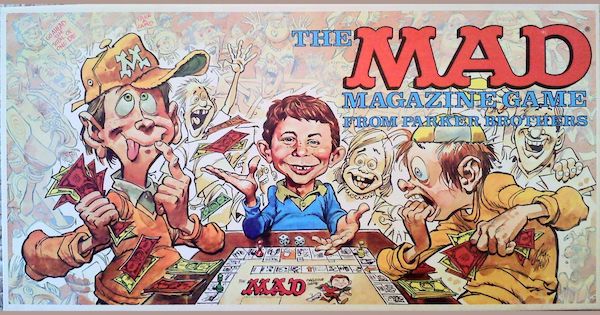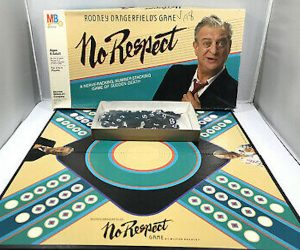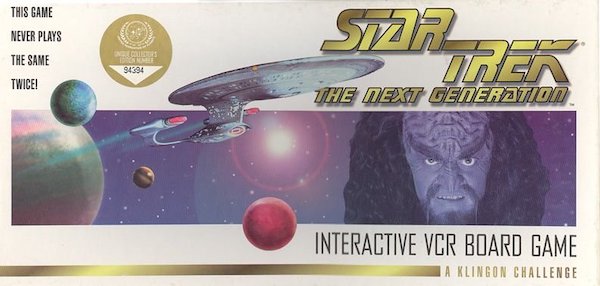Arts Commentary: It’s OK to Like Board Games, Even the Bad Ones
By John-Michael Gariepy
These cheesy board games were repetitive and horrible and I loved every one of them.

When I was a kid, my Ma wallpapered houses and dragged me along. I spent much of my childhood in the houses of strangers. If I was lucky, there was someone my age around or an Atari 2600 to play with. But most of the time I kept myself company. I read Endless Quest books and children’s encyclopedias. I pored over 5,000-piece jigsaw puzzles and tinkered with a plastic suitcase full of Legos. And I soloed on a lot of board games, giving each imaginary player a personality and a set of tactics. I ran them through the gamut, over and over.
Ma knew I loved board games so I tended to get a new one every Christmas and birthday. But my parents didn’t play board games themselves, so I was saddled with whatever example of Milton Bradley box art looked attractive while we were wandering the aisles of Service Merchandise. Screaming Eagles featured F-16 fighters on adjustable bases locked in a never-ending dogfight. The Mad Magazine Game trotted pawns through a steeplechase of gags, with the first person to lose all their money declared the winner (the game also featured a single $1,329,063 bill which, once gained, was nigh impossible to get rid of). In the Rodney Dangerfield board game, No Respect, players had to … actually I still don’t know what you were supposed to do in that game. At the height of Dangerfield’s success, he asked for a game to be made with no respect, and Milton Bradley tossed him a board and a pile of numbered tiles and said, “Make it yourself.”
So yes, it’s not surprising that I grew up to love board games. And I lucked out, because we’re living in the golden age of tabletop gaming right now. Every now and then I catch a review from a book or movie reviewer who has been saddled with evaluating a board game and it’s clear they never got the memo. They talk about how surprising it is to see a board game — weren’t they “obsoleted” by the video game market? They’re wrong. The board game market hooked a rope to the spoiler of video games, and it’s been catching wave after wave in tow. Kickstarter alone saw over a billion dollars pledged toward games by 2019, with 69% of that funding going to tabletop games. And, surprise, surprise, in 2020, the year everyone was trapped indoors and forced to socialize with their roomies, board game sales witnessed record numbers. We are gilding the blossom of an ever-flowering art form, though I suspect most people have yet to recognize the bloom growing in their backyard.
And board games are art. I can’t conceive how one could argue against it. There’s the obvious artwork that bespangles the surface of the box, board, cards, dice, and chits, as well as the overall aesthetic choices in the design of the objects and how they combine into engaging, if sometimes chaotic, shapes. And don’t forget the set of instructions that controls and paces the flow of play — transforming players into actors in a contest where the choices they make determine their fate. Board games are the ultimate in audience participation/performance art. It’s culture in a box, ready to unravel and test combatants, who are also participants guided into sharing surprising little discoveries.
 With all art comes innovation. Over the past three decades, designers made conscious choices to get rid of “roll to move” mechanics, player elimination, time out, and loss of control elements that lead to “feel bad” moments. There’s also been an increase in abstract thinking party games, a surge of co-op games where the players fight the board, games featuring tight resource management with a surprising array of potential strategies, and a recent push toward one-player, print and play games. As more games enter the common lexicon, more tools become available, and more designers mix and match these tools to push the limits of cardboard. And, while no game will ever be perfect, many of them have proved to be great in a number of different ways.
With all art comes innovation. Over the past three decades, designers made conscious choices to get rid of “roll to move” mechanics, player elimination, time out, and loss of control elements that lead to “feel bad” moments. There’s also been an increase in abstract thinking party games, a surge of co-op games where the players fight the board, games featuring tight resource management with a surprising array of potential strategies, and a recent push toward one-player, print and play games. As more games enter the common lexicon, more tools become available, and more designers mix and match these tools to push the limits of cardboard. And, while no game will ever be perfect, many of them have proved to be great in a number of different ways.
As a game reviewer, I had the pleasure of watching these games mature throughout the Kickstarter revolution. I went from being a person who admired games that I now think of as being flawed to becoming an advocate for clever, intricate, and player-friendly designs. My friends’ tastes matured as well. We talked on podcasts about what we enjoyed and did not. And we invested in games the same way people support art: we became patrons to designers who earned our respect or caught our eye. We helped to fund their craft and received a piece of their legacy. These little masterpieces were respectfully placed on top of our very tall “to be played” stack. Long gone were the drunken pool house parties enlivened by a deck of Boom-O: everyone laughed at the one player whose bomb’s timer was always reset to zero seconds from exploding. Gone were the epic Risk bouts of my college days in which some poor schmuck was stuck defending their third of the world against the player who squatted on Australia until the light of dawn poked through the window shades. Gone were the days of OK Soda and Axis & Allies in a friend’s basement on a hot summer day, when setting up the game took almost as long as a single player’s turn of endless dice rolls.
They’re long gone. And I cannot say I am having more fun with my hobby now than I did then.
In the ’50s, the movie industry also went through a similar surge of entertainment high and low. Some directors took advantage of the possibilities to create masterpieces like On the Waterfront and A Streetcar Named Desire. Others took advantage of the cheaper camera and production costs and parlayed audience interest in the fantastic to create stunningly bad movies like The Man from Planet X and Plan 9 from Outer Space. At the time, these hack movies were panned — if reviewed at all by serious critics. But they were an awful lot of fun. Over time, exhibitors learned that they could pack a midnight showing, night after night, for the latest tawdry Boris Karloff romp. A new expression played on people’s lips: “It’s so bad, it’s good.” Some movies are terrible and that can be satisfying. We don’t need to treat them seriously, except to seriously heckle them. It isn’t necessary to hang on every word. Let the TV flicker in the background while we talk on the phone or grab a snack. Our expectations are low, and when those expectations are delivered upon, it’s catharsis.
A lot of modern game reviewers seem unable to understand this principle. Mind you, these are game reviewers with opinions I appreciate and respect, many of whom are smarter than I am. But they don’t seem capable of appreciating being the butt of the joke. They don’t get why a player might want to do everything right, and still get the rug swept out from under them. They find it all anathema: the embrace of wasted time, endless deck shuffling, minor meaningless paper money transactions, turn skipping, and the sort of dice-rolling that leads to carpal tunnel. These critics, who play a dozen different games weekly, can’t appreciate the value of purposeless grinding while kibitzing with friends. I disagree with these reviewers, but I can’t say I blame them.
It happens to me too. Sometimes when I’m reviewing a game I forget to check what the game is doing right as an experience. Most games do something right. After all, the vast majority of games weren’t issued from the board room, but were created by designers who are passionate about their craft. Those designers want to share something with you. And if that’s my margin for success — for a game to stimulate a shared experience — then most games I have played are successful.

After all these years, that’s all I ever wanted from a board game. I wanted someone to spend time with and interact with me as I sat on the carpet, waiting for Ma to call me over to clean up the discarded wallpaper scraps. I didn’t want my conventional suspicions to be confirmed; I wanted to be surprised. And many of those terrible games did that. Whether it was Mall Madness mocking me (?) when it inevitably rejected my credit card to buy something in the electronics store, or the Klingon from the Star Trek: the Next Generation Interactive VCR game who demanded that I answer him with a stout “Yes, Captain Kavok!” before, yet again, I found myself locked in a stasis field. These games were repetitive and horrible and I loved every one of them.
They don’t make ’em like they used to, and that’s good. Modern board games aren’t cheap.
That said, even if you’re up for the challenge of playing a game like Risk, you still need to convince your friends that yes, this dumb beast of a game can be fun to play. The simplest approach is to select a game that was good in its heyday but has fallen out of favor. It’s far easier to pitch something with an attractive sheen of past notoriety, now buffed to a shine by nostalgia. But if nostalgia isn’t working as a hook, then I recommend doubling down on the good/bad vibes. Nothing pairs better with a bad game than a bad movie, both played simultaneously.
So dust off that copy of Fireball Island, polish those fireballs, and wreak havoc upon a tropical island as our intrepid adventurers fight to steal the giant ruby from the tiki idol Vul-Kar. When you’re done, you can always play something more involved and introspective — but there’s no rush. If you’re having fun while playing a game, then you already won.
John-Michael Gariepy has reviewed over 400 board games between three podcasts over the past decade. But he’s far more excited to show off his new book: Winning Streak: Tales and Trivia of the 40 Most Popular Board Games which can be found at www.winningstreakbook.com.

Hi J.M.:
Fascinating reading. I can just picture you playing and reading while your Mother was at work. I can almost “Star Trek” myself back in time for reflection. As you know, I have 65% completion of War and Peace. I enjoy literature that allows the reader the opportunity to transcend time. Your writings allow that appreciated dimensional opportunity.
Dad
Hi Dad! Glad you enjoyed! You owe me a game of Chinese checkers or parcheesi, and I plan to collect soon. 😉
This is a great article and I totally agree. I have recently purchased several “vintage” games from the 60s and 70s that I used to play or always wanted. I collect those while my daughter has purchased enough “new” tabletop games that we could open our own gaming store. We play almost nightly, it’s a great way to spend time with my daughter and keeps me from watching too much TV! Currently favorites are Splendor, Wingspan, 7 Wonders, Lost Cities and Res Arcana.
[…] Kings and Things. Which has strange parallels to an article I wrote for the Arts Fuse: It’s OK to Like Board Games, Even the Bad Ones, in which I delve into when I was a kid and used to play board games by myself in other […]